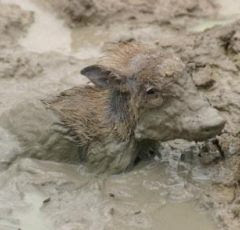 The Hopi, or Hopituh Shi-nu-mu, "The Peaceful People" or "Peaceful Little Ones," call their ancestors Hisatsinom, ("ee-SAH-tse-nom"), which means the ancient ones. The Navajo use the word Anasazi, which means ancient enemies. As Hopi they have lived in the Four Corners area for at least 1,000 years. Oraibi, AZ was settled in 1050 and is the oldest consistently occupied community in North America. Wherever they have lived, the Hopi have always been the Hopi. It is the scientists who use other names.
The Hopi, or Hopituh Shi-nu-mu, "The Peaceful People" or "Peaceful Little Ones," call their ancestors Hisatsinom, ("ee-SAH-tse-nom"), which means the ancient ones. The Navajo use the word Anasazi, which means ancient enemies. As Hopi they have lived in the Four Corners area for at least 1,000 years. Oraibi, AZ was settled in 1050 and is the oldest consistently occupied community in North America. Wherever they have lived, the Hopi have always been the Hopi. It is the scientists who use other names. I've been to Old Oraibi on 3 occasions over the decades. First in '69 with two friends on our way to Canada as draft resisters. We walked in from the road after passing a hand painted sign instructing visitors to leave their cameras beind. We walked trough the village that early May morning followed by a little boy who darted shyly behind cover whenever we turned to greet him. All paths led to the abandoned shell of a long deserted church. We later learned the church had been struck by lightening about 100 years before and was soon abandoned by the church authorities because the Hopi heeded the lightening's message and wouldn't go inside it ever again. The little boy became less shy as our walking tour progressed, finally when we spoke with him and he invited us to visit his grandmother's house. Like all the other houses there in '69 its outter walls were made of piled stone rubble held aloft by expertly placed wooden wedges that stabilized the courses of erosion rounded stone. Inside we met one of the village elders, she spoke no english the little boy was our go between. She made herb tea for us, even through translation she answered our stupid questions with disarming affection. An hour later we walked silently through the still cold air back out to our old pickup, our east coast hippy worldview changed forever.
My next visit was in about 1980 on a road trip of dicovery and recovery through the great southwestern desert. Old Oraibi had changed some. There had been a split, now at the bottom of the impressive mesa on top of which sat the original Oraibi i passed the town of New Oraibi. Complete with satellite dishes, power lines and sewer problems New Oraibi's residents had split from their elders ways and moved to this lower location. Even the old town was changing slowly, there were a few framed, tarpaper covered, small houses intermingled with the piled stone originals. I stopped at one of the tarpaper variety because it had a small bi-lingual sign saying 'book store'. The store owner filled me in on the recent history of Oraibi's divisions. I bought 'The Hopi Cookbook' said my thanks and drove on. The cookbook stayed with me through all these years and provided me with many great ideas for preparing and enjoying the bounty of our garden in a simple, traditional, Hopi style.
The final stop, so far anyway, was in '90. This time my new partner and our beautiful little baby were along for the ride. We had a goal in mind on this visit, to bring back Hopi corn for our garden. We tried at all times to grow open pollinated heritage varities of as many crops as we could, Hopi corn is as heritage as there is. We stopped by the newly constructed Hopi Cultural Center [ great idea in that the area gets so many visitors/seekers that its villages were being overrun by us]. There we met quite a few young Hopi inside and out. One was a young lady farmer. She directed us to her farm where we could buy each of the four ancient types of seed corn. We brought it back to our little farm on the southwest coast of British Columbia, we planted them all but the only one to survive well enough to save for re-planting was the yellow. Interestingly the Hopi's 4 corn colors each correspond to a direction and the winds from that direction, the yellow's direction and wind is from the northwest just like us. We ate, we dried, saved and re-planted year after year for 15 years. We passed the seed on to other small farmers in our area. It was good, it was real, it still is.
The Hopi Worldview


